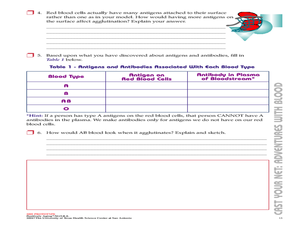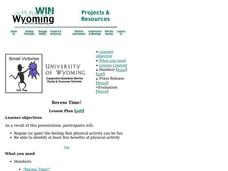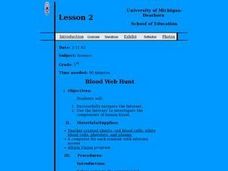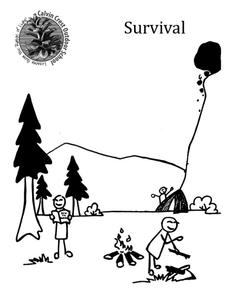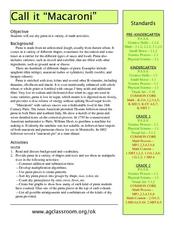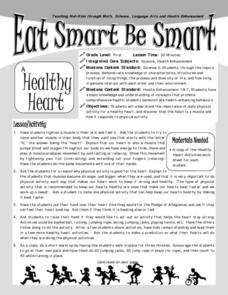Curated OER
In Cold Blood: Cloze Procedure
What is the reading level of your language arts or English class? If you're not sure if In Cold Blood would be an appropriate reading level for your kids, give them this cloze procedure. They read the complete reading selection once, and...
Curated OER
Antibody Center Template
In this antibodies learning exercise, students use model diagrams of antigens, antibodies and blood cells to develop a visual understanding of the immune system. They draw diagrams of antibodies and antigens attached to each other and...
Curated OER
How Do White Blood Cells Fight Foreign Organisms That Invade Our Body?
Ninth graders investigate the functions of white blood cells. They watch and discuss an online movie, conduct Internet research, and complete a worksheet.
Curated OER
Benefits of Physical Activity
Identify at least five benefits of physical activity and guide young scholars to experience fun feeling healthy. Your class will participate in the Synchronized Chair Dance. Worksheet and Evaluation are included.
Curated OER
Turtle and Tortoise Preschool Lesson Plan
One of the best parts about teaching the littlest learners is that you can create thematic lessons that use one topic to address every subject. Here is a nice set of thematic teaching ideas that uses turtles and tortoises to teach...
Curated OER
Pre-Hardy-Weinberg
Students examine the inheritance of ABO blood groups. In this investigative instructional activity students perform a lab and show how natural selection can alter the gene frequencies in a population.
Ask A Biologist
Viral Attack
Can you catch the same cold twice? Elementary and middle schoolers learn about what happens when a virus attacks their bodies, and how the immune system never forgets a virus, with an entertaining comic book. The packet includes...
Curated OER
World Blood Donor Day
In this World Blood Donor Day worksheet, students complete activities such as reading a passage, phrase matching, fill in the blanks, correct words, multiple choice, spelling, sequencing, scrambled sentences, writing questions, survey,...
Curated OER
P.L.E.P: Parts of Blood
Students examine the different parts of blood. In this human blood lesson students work in groups and identify parts of blood and construct a model of human blood.
Curated OER
Cord Blood Banking and Transplantation
Learners explore stem cells. In this stem cell lesson, students research print and Internet sources regarding types of stem cells and their attributes. Learners discuss their research findings participate in a debate about cord blood...
Curated OER
What is BAC?-Blood Alcohol Concentration
In this blood alcohol activity, students read about the factors that affect a person's blood alcohol concentration. Students use a given formula to calculate the amount of alcohol in a list of four different drinks and apply their...
Curated OER
Blood Components Web Hunt
Fifth graders watch a short video on blood and complete worksheets on the components of blood. They navigate the Internet to investigate the components of human blood. They complete worksheets with a partner and exchange sheets among...
Curated OER
Enzymes Help Us Digest Food ~ Introduction to Sugars and Enzymes
After an explanatory introduction to sugars and enzyme activity, biochemists discover whether lactase is needed to digest lactose, sucrose, and milk as a whole. High school science lab skills are required for these investigations.
Curated OER
Crime Scene Investigation - Biology Teaching Thesis
Learners explore the different blood types, and are introduced to new knowledge through a crime scene simulated activity. They explore the genetics of blood types, and are introduced to immunology/diseases.
Center for Technology in Teaching and Learning
CSI: The Experience - Family Forensics
Forensic scientists depend on their observation skills to analyze evidence down to the molecular level. Middle and high schoolers practice making observations and predictions with a series of crime scene activities, which includes a...
Calvin Crest Outdoor School
Survival
Equip young campers with important survival knowledge with a set of engaging lessons. Teammates work together to complete three outdoor activities, which include building a shelter, starting a campfire, and finding directions in the...
Nuffield Foundation
A Closer Look at Blood
Here is a lab that has teenage scientists examining samples of their own blood under a microscope. Learners carefully prepare slides, then make detailed observations and identifying different types of cells using a key.
Science 4 Inquiry
Genetics, Genetics, and More Genetics: Exploring Independent Assortment and Non-Mendelian Genetics
Two individuals share 99.9 percent of their genetic codes, yet diversity is observed everywhere. Young scientists learn about diversity through hands-on activities and an experiment. They apply the concepts of independent assortment and...
Curated OER
Call it "Macaroni"
Who knew there were so many fun educational opportunities featuring pasta? Scholars read a brief informational text about the history of pasta (note that "macaroni" is spelled two different ways, so address this if kids are reading...
Curated OER
I Can Balance. You Can Balance.
It's disturbing to think that one third of children born after the year 2000 will suffer from diabetes and perhaps be the first generation to live shorter lives than their parents! Too many youngsters are not eating properly and are not...
Montana Office of Public Instruction
Eat Smart Be Smart
Get children's blood pumping with this primary grade instructional activity on the human heart. After learning about the important role this muscle plays in the human body, students monitor their heart rates and discover the...
Curated OER
Compare and Contrast Type 1 and Type 2 Diabetes
Young scholars use graphic organizers to compare and contrast Type 1 and Type 2 diabetes. In this diabetes lesson, students are given information on the two major types of diabetes. They analyze how to compare and contrast the information.
Curated OER
Body Battles!
Seventh graders explain the role of white blood cells in fighting infections. In this life science lesson, 7th graders create flow charts showing the immune response process. They act out and play a game to simulate actions of the immune...
Curated OER
Blood Web Hunt
Fifth graders examine the components of blood. Using internet websites and a handout, 5th graders search for answers to questions about blood. They explore components such as red blood cells, white blood cells, platelet and plasma.



